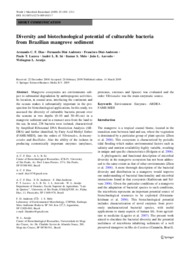Diversity and biotechnological potential of culturable bacteria from Brazilian mangrove sediment.
Diversity and biotechnological potential of culturable bacteria from Brazilian mangrove sediment.
Author(s): DIAS, A. C. F.; ANDREOTE, F. D.; DINI-ANDREOTE, F.; LACAVA, P. T.; SÁ, A. L. B.; MELO, I. S. de; AZEVEDO, J. L.; ARAUJO, W. L.
Summary: Mangrove ecosystems are environments subject to substantial degradation by anthropogenic activities. Its location, in coastal area, interfacing the continents and the oceans makes it substantially important in the prospection for biotechnological applications. In this study, we assessed the diversity of culturable bacteria present over the seasons at two depths (0-10 and 30-40 cm) in a mangrove sediment and in a transect area from the land to the sea. In total, 238 bacteria were isolated, characterized by Amplified Ribosomal DNA Restriction Analysis (ARDRA) and further identified, by Fatty Acid Methyl Esther (FAME-MIDI), into the orders of Vibrionales, Actinomycetales and Bacillales. Also the ability of the isolates in producing economically important enzymes (amylases, proteases, esterases and lipases) was evaluated and the order Vibrionales was the main enzymatic source.
Publication year: 2009
Types of publication: Journal article
Unit: Embrapa Environment
Keywords: Biotecnologia, Mangue
Observation
Some of Embrapa's publications are published as ePub files. To read them, use or download one of the following free software options to your computer or mobile device. Android: Google Play Books; IOS: iBooks; Windows and Linux: Calibre.
Access other publications
Access the Agricultural Research Database (BDPA) to consult Embrapa's full library collection and records.
Visit Embrapa Bookstore to purchase books and other publications sold by Embrapa.

